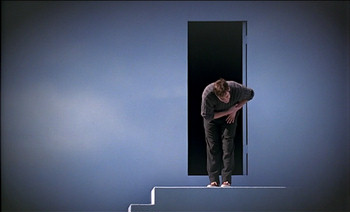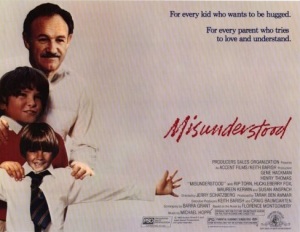Five Minutes: Pan’s Labyrinth
 In a previous entry, I noted the disconnect between Guillermo del Toro’s assertion that Pan’s Labyrinth is “not about sexual identity” and the movie’s marketing materials and design.
In a previous entry, I noted the disconnect between Guillermo del Toro’s assertion that Pan’s Labyrinth is “not about sexual identity” and the movie’s marketing materials and design.
 In a previous entry, I noted the disconnect between Guillermo del Toro’s assertion that Pan’s Labyrinth is “not about sexual identity” and the movie’s marketing materials and design.
In a previous entry, I noted the disconnect between Guillermo del Toro’s assertion that Pan’s Labyrinth is “not about sexual identity” and the movie’s marketing materials and design.
 When we say that a movie is more style than substance, we typically mean it derisively. Oliver Stone’s JFK has a ton of stuff – with the director’s cut running nearly three and a half hours – that was mistaken for its substance. But the meat of the movie is its style, because it’s the fuel that made the film so combustible.
When we say that a movie is more style than substance, we typically mean it derisively. Oliver Stone’s JFK has a ton of stuff – with the director’s cut running nearly three and a half hours – that was mistaken for its substance. But the meat of the movie is its style, because it’s the fuel that made the film so combustible.
 I suggested it, jokingly, when I announced the Misunderstood Blog-a-thon: “Is E.T. really a sophisticated exploration of diaspora?” But the more I think of it, the more it makes sense.
I suggested it, jokingly, when I announced the Misunderstood Blog-a-thon: “Is E.T. really a sophisticated exploration of diaspora?” But the more I think of it, the more it makes sense.
 There’s a maxim that says a movie teaches you how to watch it, but Peter Weir’s The Truman Show teaches you how to watch it the wrong way. And in its brazen audience cues, it hints that you should question your reaction to the film. This is a movie that was made for misunderstanding.
There’s a maxim that says a movie teaches you how to watch it, but Peter Weir’s The Truman Show teaches you how to watch it the wrong way. And in its brazen audience cues, it hints that you should question your reaction to the film. This is a movie that was made for misunderstanding.
 Why does nobody take the frogs seriously? Why does nobody question them? In Paul Thomas Anderson’s Magnolia, the cataclysmic, apocalyptic rain of frogs seems casually accepted. Nobody says: “That’s some fucked-up shit, those frogs.”
Why does nobody take the frogs seriously? Why does nobody question them? In Paul Thomas Anderson’s Magnolia, the cataclysmic, apocalyptic rain of frogs seems casually accepted. Nobody says: “That’s some fucked-up shit, those frogs.”
(Part of the Misunderstood Blog-a-thon.) I did something I’ve never done before. I’ve been an avid (rabid?) movie fan since I was too young to remember. Even today it’s a rare day that I don’t watch at least two movies, more on weekends. But I have never, never (my inner drama queen insists I repeat this for emphasis) watched a movie and immediately turned around and watched it again from the beginning, all in one sitting.
(Part of the Misunderstood Blog-a-thon.) Edward Zwick is a more-than-competent director who has made some capable movies, and some that I physically detest. This is largely the fault of his love of the “ideal worth dying for,” which is central to most of his movies. I, on the other hand, feel few ideals are worth even discussing, let alone dying for. “Idealist” isn’t a snide put-down without reason.
It’s important to misunderstand movies. Put another way: If we limit ourselves to straightforward readings of plot or themes in film, we’re denying ourselves the multifaceted nature of the medium. As the most inclusive of all the arts, cinema comprises narrative storytelling, photography, acting, sound, music, speech, movement, costume, montage, and architecture. Even the dumbest, most-crass summer blockbuster is a dense, nearly infinite trove of material to explore and analyze.
 Have you ever read or heard a discussion of a movie that made you think, They just don’t get it? Have you ever wondered, Am I the only person who saw the movie that way? Culture Snob is hosting a forum for essays, arguments, and provocations on misunderstood movies. The blog-a-thon will run Wednesday, May 16, through Sunday, May 20, although I won’t turn my nose up at contributions that arrive before then. The premise is that movies are marketed and evaluated coarsely and simplistically, and that they often contain a richness that’s never mined by critics and casual audiences.
Have you ever read or heard a discussion of a movie that made you think, They just don’t get it? Have you ever wondered, Am I the only person who saw the movie that way? Culture Snob is hosting a forum for essays, arguments, and provocations on misunderstood movies. The blog-a-thon will run Wednesday, May 16, through Sunday, May 20, although I won’t turn my nose up at contributions that arrive before then. The premise is that movies are marketed and evaluated coarsely and simplistically, and that they often contain a richness that’s never mined by critics and casual audiences.